Warehousing and Distribution Issues: Analytical Tools and Aw Rostamani
VerifiedAdded on 2023/06/05
|7
|2312
|354
Essay
AI Summary
This essay addresses issues in warehousing and distribution, focusing on analytical tools such as inventory analytics, SAP warehouse management system, and PeopleSoft supply chain analytics. It discusses how these tools can improve inventory management, streamline warehouse operations, and provide real-time data for better decision-making. The benefits and drawbacks of each tool are analyzed, with a specific recommendation for SAP warehouse management (WM) for Aw Rostamani, a UAE-based organization. SAP WM is highlighted for its ability to optimize warehouse space, reduce costs, improve inventory visibility, and enhance traceability, ultimately leading to improved business efficiency and customer satisfaction. The essay concludes that while each tool has its merits, SAP WM is particularly well-suited for addressing warehousing and distribution challenges due to its cost-effectiveness, efficiency, and comprehensive features compared to inventory analytics and PeopleSoft.

WAREHOUSING AND
DISTRIBUTION ISSUES
1
DISTRIBUTION ISSUES
1
Paraphrase This Document
Need a fresh take? Get an instant paraphrase of this document with our AI Paraphraser

TABLE OF CONTENTS
REFERENCES................................................................................................................................3
REFERENCES................................................................................................................................3
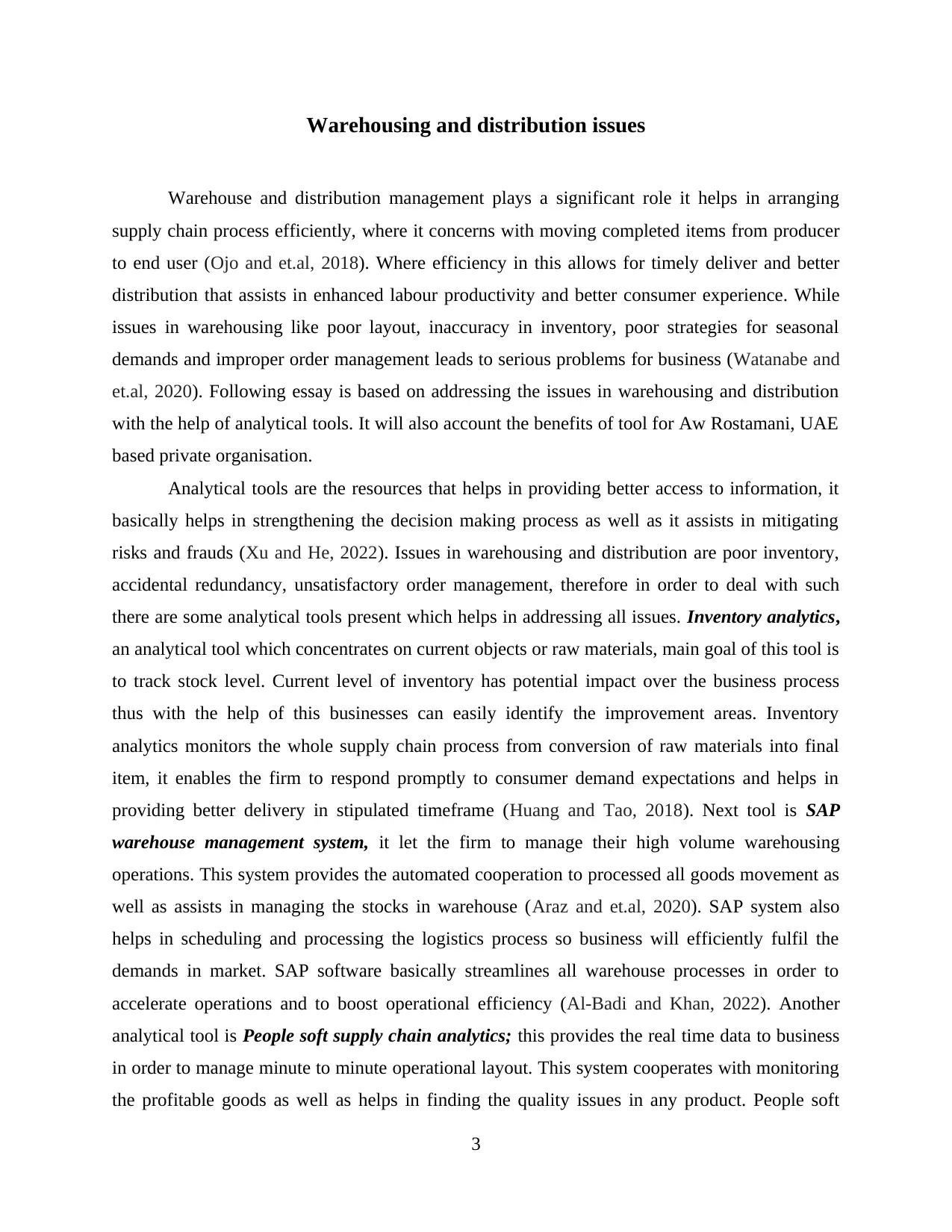
Warehousing and distribution issues
Warehouse and distribution management plays a significant role it helps in arranging
supply chain process efficiently, where it concerns with moving completed items from producer
to end user (Ojo and et.al, 2018). Where efficiency in this allows for timely deliver and better
distribution that assists in enhanced labour productivity and better consumer experience. While
issues in warehousing like poor layout, inaccuracy in inventory, poor strategies for seasonal
demands and improper order management leads to serious problems for business (Watanabe and
et.al, 2020). Following essay is based on addressing the issues in warehousing and distribution
with the help of analytical tools. It will also account the benefits of tool for Aw Rostamani, UAE
based private organisation.
Analytical tools are the resources that helps in providing better access to information, it
basically helps in strengthening the decision making process as well as it assists in mitigating
risks and frauds (Xu and He, 2022). Issues in warehousing and distribution are poor inventory,
accidental redundancy, unsatisfactory order management, therefore in order to deal with such
there are some analytical tools present which helps in addressing all issues. Inventory analytics,
an analytical tool which concentrates on current objects or raw materials, main goal of this tool is
to track stock level. Current level of inventory has potential impact over the business process
thus with the help of this businesses can easily identify the improvement areas. Inventory
analytics monitors the whole supply chain process from conversion of raw materials into final
item, it enables the firm to respond promptly to consumer demand expectations and helps in
providing better delivery in stipulated timeframe (Huang and Tao, 2018). Next tool is SAP
warehouse management system, it let the firm to manage their high volume warehousing
operations. This system provides the automated cooperation to processed all goods movement as
well as assists in managing the stocks in warehouse (Araz and et.al, 2020). SAP system also
helps in scheduling and processing the logistics process so business will efficiently fulfil the
demands in market. SAP software basically streamlines all warehouse processes in order to
accelerate operations and to boost operational efficiency (Al-Badi and Khan, 2022). Another
analytical tool is People soft supply chain analytics; this provides the real time data to business
in order to manage minute to minute operational layout. This system cooperates with monitoring
the profitable goods as well as helps in finding the quality issues in any product. People soft
3
Warehouse and distribution management plays a significant role it helps in arranging
supply chain process efficiently, where it concerns with moving completed items from producer
to end user (Ojo and et.al, 2018). Where efficiency in this allows for timely deliver and better
distribution that assists in enhanced labour productivity and better consumer experience. While
issues in warehousing like poor layout, inaccuracy in inventory, poor strategies for seasonal
demands and improper order management leads to serious problems for business (Watanabe and
et.al, 2020). Following essay is based on addressing the issues in warehousing and distribution
with the help of analytical tools. It will also account the benefits of tool for Aw Rostamani, UAE
based private organisation.
Analytical tools are the resources that helps in providing better access to information, it
basically helps in strengthening the decision making process as well as it assists in mitigating
risks and frauds (Xu and He, 2022). Issues in warehousing and distribution are poor inventory,
accidental redundancy, unsatisfactory order management, therefore in order to deal with such
there are some analytical tools present which helps in addressing all issues. Inventory analytics,
an analytical tool which concentrates on current objects or raw materials, main goal of this tool is
to track stock level. Current level of inventory has potential impact over the business process
thus with the help of this businesses can easily identify the improvement areas. Inventory
analytics monitors the whole supply chain process from conversion of raw materials into final
item, it enables the firm to respond promptly to consumer demand expectations and helps in
providing better delivery in stipulated timeframe (Huang and Tao, 2018). Next tool is SAP
warehouse management system, it let the firm to manage their high volume warehousing
operations. This system provides the automated cooperation to processed all goods movement as
well as assists in managing the stocks in warehouse (Araz and et.al, 2020). SAP system also
helps in scheduling and processing the logistics process so business will efficiently fulfil the
demands in market. SAP software basically streamlines all warehouse processes in order to
accelerate operations and to boost operational efficiency (Al-Badi and Khan, 2022). Another
analytical tool is People soft supply chain analytics; this provides the real time data to business
in order to manage minute to minute operational layout. This system cooperates with monitoring
the profitable goods as well as helps in finding the quality issues in any product. People soft
3
⊘ This is a preview!⊘
Do you want full access?
Subscribe today to unlock all pages.

Trusted by 1+ million students worldwide
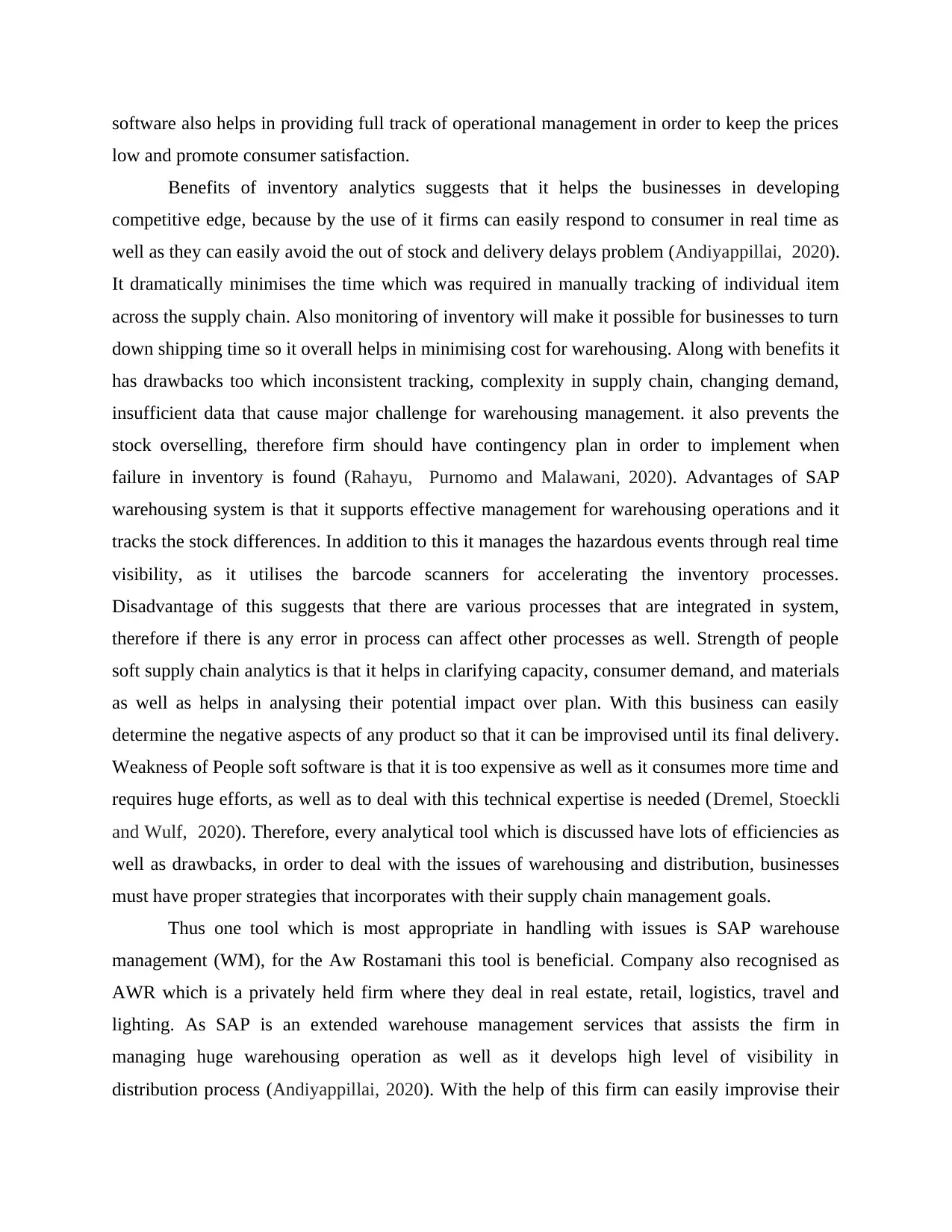
software also helps in providing full track of operational management in order to keep the prices
low and promote consumer satisfaction.
Benefits of inventory analytics suggests that it helps the businesses in developing
competitive edge, because by the use of it firms can easily respond to consumer in real time as
well as they can easily avoid the out of stock and delivery delays problem (Andiyappillai, 2020).
It dramatically minimises the time which was required in manually tracking of individual item
across the supply chain. Also monitoring of inventory will make it possible for businesses to turn
down shipping time so it overall helps in minimising cost for warehousing. Along with benefits it
has drawbacks too which inconsistent tracking, complexity in supply chain, changing demand,
insufficient data that cause major challenge for warehousing management. it also prevents the
stock overselling, therefore firm should have contingency plan in order to implement when
failure in inventory is found (Rahayu, Purnomo and Malawani, 2020). Advantages of SAP
warehousing system is that it supports effective management for warehousing operations and it
tracks the stock differences. In addition to this it manages the hazardous events through real time
visibility, as it utilises the barcode scanners for accelerating the inventory processes.
Disadvantage of this suggests that there are various processes that are integrated in system,
therefore if there is any error in process can affect other processes as well. Strength of people
soft supply chain analytics is that it helps in clarifying capacity, consumer demand, and materials
as well as helps in analysing their potential impact over plan. With this business can easily
determine the negative aspects of any product so that it can be improvised until its final delivery.
Weakness of People soft software is that it is too expensive as well as it consumes more time and
requires huge efforts, as well as to deal with this technical expertise is needed (Dremel, Stoeckli
and Wulf, 2020). Therefore, every analytical tool which is discussed have lots of efficiencies as
well as drawbacks, in order to deal with the issues of warehousing and distribution, businesses
must have proper strategies that incorporates with their supply chain management goals.
Thus one tool which is most appropriate in handling with issues is SAP warehouse
management (WM), for the Aw Rostamani this tool is beneficial. Company also recognised as
AWR which is a privately held firm where they deal in real estate, retail, logistics, travel and
lighting. As SAP is an extended warehouse management services that assists the firm in
managing huge warehousing operation as well as it develops high level of visibility in
distribution process (Andiyappillai, 2020). With the help of this firm can easily improvise their
low and promote consumer satisfaction.
Benefits of inventory analytics suggests that it helps the businesses in developing
competitive edge, because by the use of it firms can easily respond to consumer in real time as
well as they can easily avoid the out of stock and delivery delays problem (Andiyappillai, 2020).
It dramatically minimises the time which was required in manually tracking of individual item
across the supply chain. Also monitoring of inventory will make it possible for businesses to turn
down shipping time so it overall helps in minimising cost for warehousing. Along with benefits it
has drawbacks too which inconsistent tracking, complexity in supply chain, changing demand,
insufficient data that cause major challenge for warehousing management. it also prevents the
stock overselling, therefore firm should have contingency plan in order to implement when
failure in inventory is found (Rahayu, Purnomo and Malawani, 2020). Advantages of SAP
warehousing system is that it supports effective management for warehousing operations and it
tracks the stock differences. In addition to this it manages the hazardous events through real time
visibility, as it utilises the barcode scanners for accelerating the inventory processes.
Disadvantage of this suggests that there are various processes that are integrated in system,
therefore if there is any error in process can affect other processes as well. Strength of people
soft supply chain analytics is that it helps in clarifying capacity, consumer demand, and materials
as well as helps in analysing their potential impact over plan. With this business can easily
determine the negative aspects of any product so that it can be improvised until its final delivery.
Weakness of People soft software is that it is too expensive as well as it consumes more time and
requires huge efforts, as well as to deal with this technical expertise is needed (Dremel, Stoeckli
and Wulf, 2020). Therefore, every analytical tool which is discussed have lots of efficiencies as
well as drawbacks, in order to deal with the issues of warehousing and distribution, businesses
must have proper strategies that incorporates with their supply chain management goals.
Thus one tool which is most appropriate in handling with issues is SAP warehouse
management (WM), for the Aw Rostamani this tool is beneficial. Company also recognised as
AWR which is a privately held firm where they deal in real estate, retail, logistics, travel and
lighting. As SAP is an extended warehouse management services that assists the firm in
managing huge warehousing operation as well as it develops high level of visibility in
distribution process (Andiyappillai, 2020). With the help of this firm can easily improvise their
Paraphrase This Document
Need a fresh take? Get an instant paraphrase of this document with our AI Paraphraser
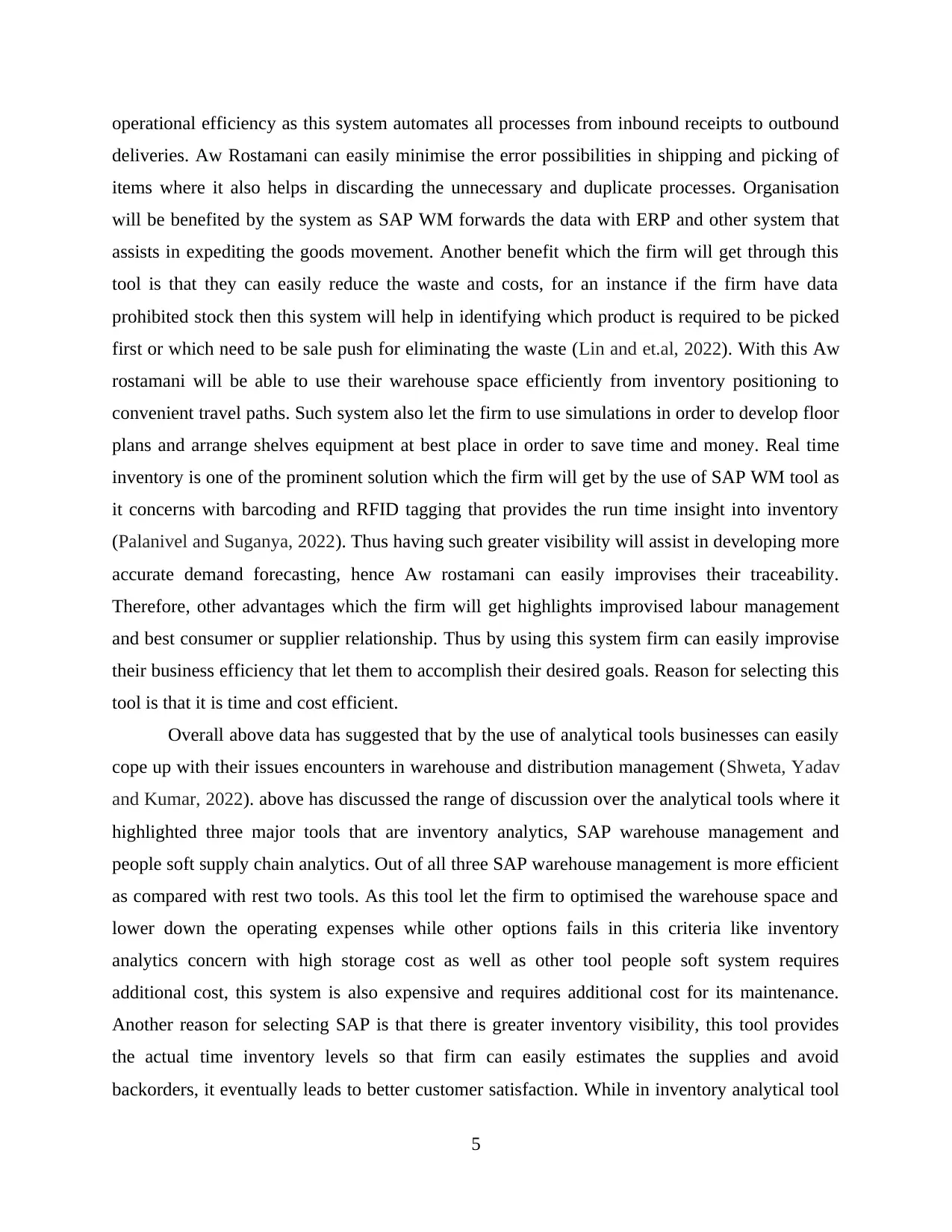
operational efficiency as this system automates all processes from inbound receipts to outbound
deliveries. Aw Rostamani can easily minimise the error possibilities in shipping and picking of
items where it also helps in discarding the unnecessary and duplicate processes. Organisation
will be benefited by the system as SAP WM forwards the data with ERP and other system that
assists in expediting the goods movement. Another benefit which the firm will get through this
tool is that they can easily reduce the waste and costs, for an instance if the firm have data
prohibited stock then this system will help in identifying which product is required to be picked
first or which need to be sale push for eliminating the waste (Lin and et.al, 2022). With this Aw
rostamani will be able to use their warehouse space efficiently from inventory positioning to
convenient travel paths. Such system also let the firm to use simulations in order to develop floor
plans and arrange shelves equipment at best place in order to save time and money. Real time
inventory is one of the prominent solution which the firm will get by the use of SAP WM tool as
it concerns with barcoding and RFID tagging that provides the run time insight into inventory
(Palanivel and Suganya, 2022). Thus having such greater visibility will assist in developing more
accurate demand forecasting, hence Aw rostamani can easily improvises their traceability.
Therefore, other advantages which the firm will get highlights improvised labour management
and best consumer or supplier relationship. Thus by using this system firm can easily improvise
their business efficiency that let them to accomplish their desired goals. Reason for selecting this
tool is that it is time and cost efficient.
Overall above data has suggested that by the use of analytical tools businesses can easily
cope up with their issues encounters in warehouse and distribution management (Shweta, Yadav
and Kumar, 2022). above has discussed the range of discussion over the analytical tools where it
highlighted three major tools that are inventory analytics, SAP warehouse management and
people soft supply chain analytics. Out of all three SAP warehouse management is more efficient
as compared with rest two tools. As this tool let the firm to optimised the warehouse space and
lower down the operating expenses while other options fails in this criteria like inventory
analytics concern with high storage cost as well as other tool people soft system requires
additional cost, this system is also expensive and requires additional cost for its maintenance.
Another reason for selecting SAP is that there is greater inventory visibility, this tool provides
the actual time inventory levels so that firm can easily estimates the supplies and avoid
backorders, it eventually leads to better customer satisfaction. While in inventory analytical tool
5
deliveries. Aw Rostamani can easily minimise the error possibilities in shipping and picking of
items where it also helps in discarding the unnecessary and duplicate processes. Organisation
will be benefited by the system as SAP WM forwards the data with ERP and other system that
assists in expediting the goods movement. Another benefit which the firm will get through this
tool is that they can easily reduce the waste and costs, for an instance if the firm have data
prohibited stock then this system will help in identifying which product is required to be picked
first or which need to be sale push for eliminating the waste (Lin and et.al, 2022). With this Aw
rostamani will be able to use their warehouse space efficiently from inventory positioning to
convenient travel paths. Such system also let the firm to use simulations in order to develop floor
plans and arrange shelves equipment at best place in order to save time and money. Real time
inventory is one of the prominent solution which the firm will get by the use of SAP WM tool as
it concerns with barcoding and RFID tagging that provides the run time insight into inventory
(Palanivel and Suganya, 2022). Thus having such greater visibility will assist in developing more
accurate demand forecasting, hence Aw rostamani can easily improvises their traceability.
Therefore, other advantages which the firm will get highlights improvised labour management
and best consumer or supplier relationship. Thus by using this system firm can easily improvise
their business efficiency that let them to accomplish their desired goals. Reason for selecting this
tool is that it is time and cost efficient.
Overall above data has suggested that by the use of analytical tools businesses can easily
cope up with their issues encounters in warehouse and distribution management (Shweta, Yadav
and Kumar, 2022). above has discussed the range of discussion over the analytical tools where it
highlighted three major tools that are inventory analytics, SAP warehouse management and
people soft supply chain analytics. Out of all three SAP warehouse management is more efficient
as compared with rest two tools. As this tool let the firm to optimised the warehouse space and
lower down the operating expenses while other options fails in this criteria like inventory
analytics concern with high storage cost as well as other tool people soft system requires
additional cost, this system is also expensive and requires additional cost for its maintenance.
Another reason for selecting SAP is that there is greater inventory visibility, this tool provides
the actual time inventory levels so that firm can easily estimates the supplies and avoid
backorders, it eventually leads to better customer satisfaction. While in inventory analytical tool
5
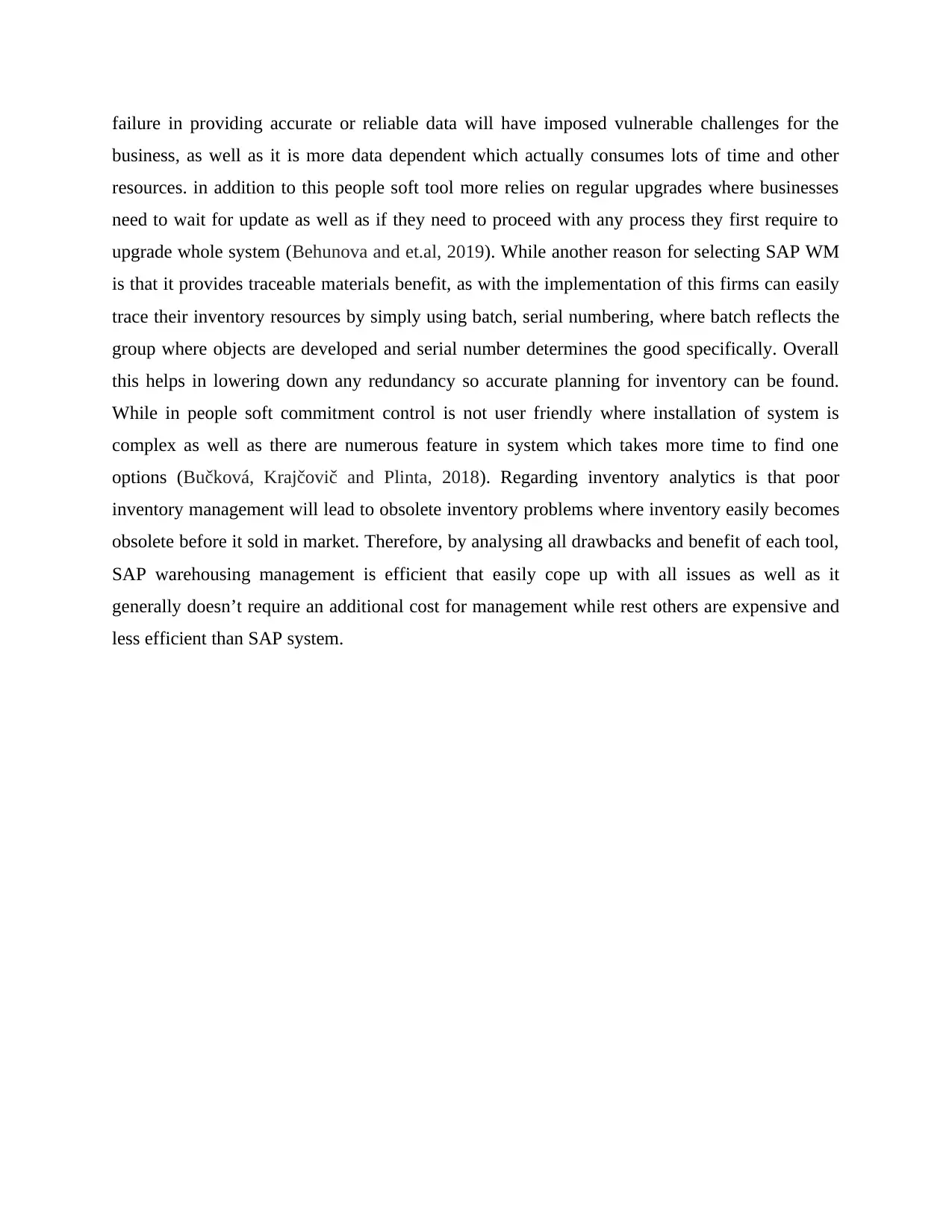
failure in providing accurate or reliable data will have imposed vulnerable challenges for the
business, as well as it is more data dependent which actually consumes lots of time and other
resources. in addition to this people soft tool more relies on regular upgrades where businesses
need to wait for update as well as if they need to proceed with any process they first require to
upgrade whole system (Behunova and et.al, 2019). While another reason for selecting SAP WM
is that it provides traceable materials benefit, as with the implementation of this firms can easily
trace their inventory resources by simply using batch, serial numbering, where batch reflects the
group where objects are developed and serial number determines the good specifically. Overall
this helps in lowering down any redundancy so accurate planning for inventory can be found.
While in people soft commitment control is not user friendly where installation of system is
complex as well as there are numerous feature in system which takes more time to find one
options (Bučková, Krajčovič and Plinta, 2018). Regarding inventory analytics is that poor
inventory management will lead to obsolete inventory problems where inventory easily becomes
obsolete before it sold in market. Therefore, by analysing all drawbacks and benefit of each tool,
SAP warehousing management is efficient that easily cope up with all issues as well as it
generally doesn’t require an additional cost for management while rest others are expensive and
less efficient than SAP system.
business, as well as it is more data dependent which actually consumes lots of time and other
resources. in addition to this people soft tool more relies on regular upgrades where businesses
need to wait for update as well as if they need to proceed with any process they first require to
upgrade whole system (Behunova and et.al, 2019). While another reason for selecting SAP WM
is that it provides traceable materials benefit, as with the implementation of this firms can easily
trace their inventory resources by simply using batch, serial numbering, where batch reflects the
group where objects are developed and serial number determines the good specifically. Overall
this helps in lowering down any redundancy so accurate planning for inventory can be found.
While in people soft commitment control is not user friendly where installation of system is
complex as well as there are numerous feature in system which takes more time to find one
options (Bučková, Krajčovič and Plinta, 2018). Regarding inventory analytics is that poor
inventory management will lead to obsolete inventory problems where inventory easily becomes
obsolete before it sold in market. Therefore, by analysing all drawbacks and benefit of each tool,
SAP warehousing management is efficient that easily cope up with all issues as well as it
generally doesn’t require an additional cost for management while rest others are expensive and
less efficient than SAP system.
⊘ This is a preview!⊘
Do you want full access?
Subscribe today to unlock all pages.

Trusted by 1+ million students worldwide
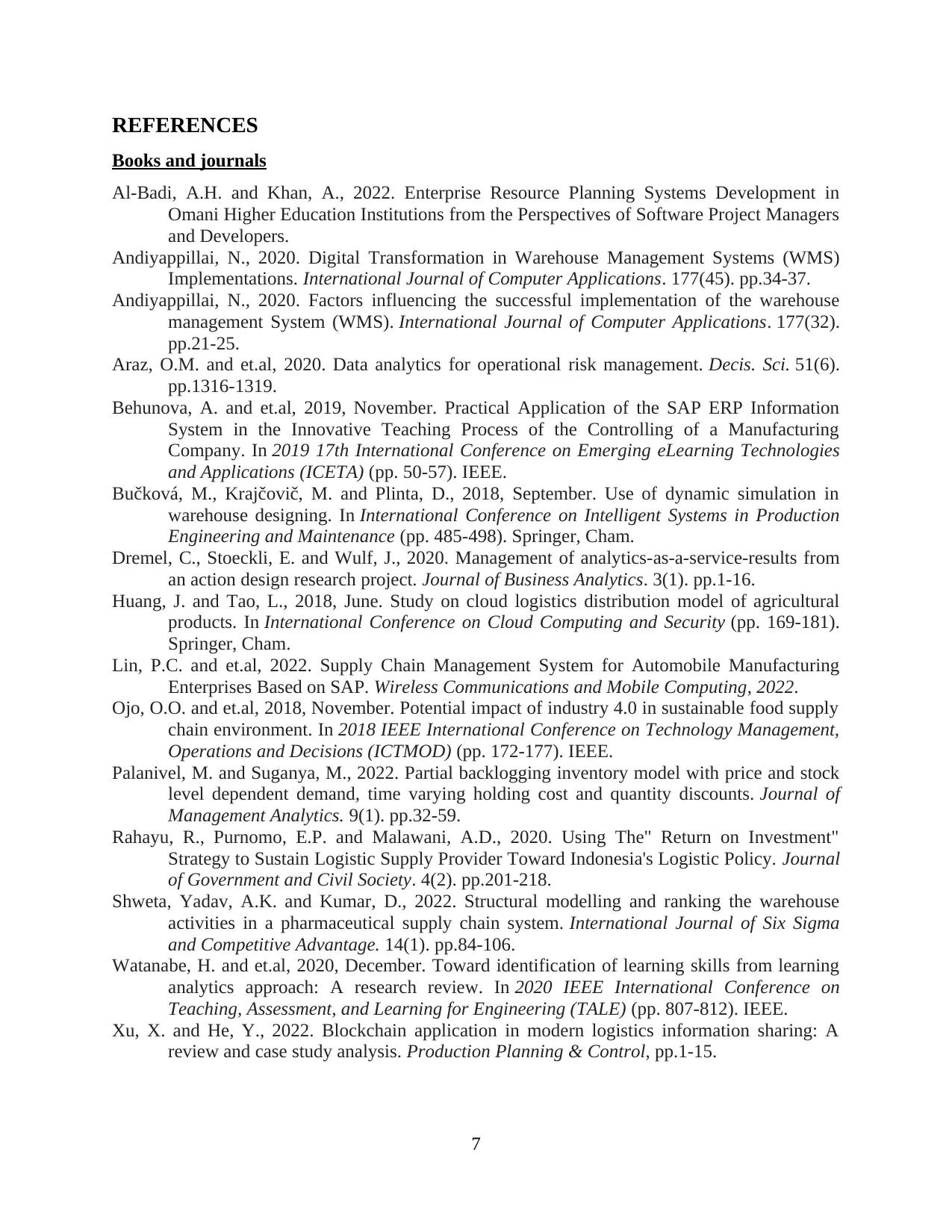
REFERENCES
Books and journals
Al-Badi, A.H. and Khan, A., 2022. Enterprise Resource Planning Systems Development in
Omani Higher Education Institutions from the Perspectives of Software Project Managers
and Developers.
Andiyappillai, N., 2020. Digital Transformation in Warehouse Management Systems (WMS)
Implementations. International Journal of Computer Applications. 177(45). pp.34-37.
Andiyappillai, N., 2020. Factors influencing the successful implementation of the warehouse
management System (WMS). International Journal of Computer Applications. 177(32).
pp.21-25.
Araz, O.M. and et.al, 2020. Data analytics for operational risk management. Decis. Sci. 51(6).
pp.1316-1319.
Behunova, A. and et.al, 2019, November. Practical Application of the SAP ERP Information
System in the Innovative Teaching Process of the Controlling of a Manufacturing
Company. In 2019 17th International Conference on Emerging eLearning Technologies
and Applications (ICETA) (pp. 50-57). IEEE.
Bučková, M., Krajčovič, M. and Plinta, D., 2018, September. Use of dynamic simulation in
warehouse designing. In International Conference on Intelligent Systems in Production
Engineering and Maintenance (pp. 485-498). Springer, Cham.
Dremel, C., Stoeckli, E. and Wulf, J., 2020. Management of analytics-as-a-service-results from
an action design research project. Journal of Business Analytics. 3(1). pp.1-16.
Huang, J. and Tao, L., 2018, June. Study on cloud logistics distribution model of agricultural
products. In International Conference on Cloud Computing and Security (pp. 169-181).
Springer, Cham.
Lin, P.C. and et.al, 2022. Supply Chain Management System for Automobile Manufacturing
Enterprises Based on SAP. Wireless Communications and Mobile Computing, 2022.
Ojo, O.O. and et.al, 2018, November. Potential impact of industry 4.0 in sustainable food supply
chain environment. In 2018 IEEE International Conference on Technology Management,
Operations and Decisions (ICTMOD) (pp. 172-177). IEEE.
Palanivel, M. and Suganya, M., 2022. Partial backlogging inventory model with price and stock
level dependent demand, time varying holding cost and quantity discounts. Journal of
Management Analytics. 9(1). pp.32-59.
Rahayu, R., Purnomo, E.P. and Malawani, A.D., 2020. Using The" Return on Investment"
Strategy to Sustain Logistic Supply Provider Toward Indonesia's Logistic Policy. Journal
of Government and Civil Society. 4(2). pp.201-218.
Shweta, Yadav, A.K. and Kumar, D., 2022. Structural modelling and ranking the warehouse
activities in a pharmaceutical supply chain system. International Journal of Six Sigma
and Competitive Advantage. 14(1). pp.84-106.
Watanabe, H. and et.al, 2020, December. Toward identification of learning skills from learning
analytics approach: A research review. In 2020 IEEE International Conference on
Teaching, Assessment, and Learning for Engineering (TALE) (pp. 807-812). IEEE.
Xu, X. and He, Y., 2022. Blockchain application in modern logistics information sharing: A
review and case study analysis. Production Planning & Control, pp.1-15.
7
Books and journals
Al-Badi, A.H. and Khan, A., 2022. Enterprise Resource Planning Systems Development in
Omani Higher Education Institutions from the Perspectives of Software Project Managers
and Developers.
Andiyappillai, N., 2020. Digital Transformation in Warehouse Management Systems (WMS)
Implementations. International Journal of Computer Applications. 177(45). pp.34-37.
Andiyappillai, N., 2020. Factors influencing the successful implementation of the warehouse
management System (WMS). International Journal of Computer Applications. 177(32).
pp.21-25.
Araz, O.M. and et.al, 2020. Data analytics for operational risk management. Decis. Sci. 51(6).
pp.1316-1319.
Behunova, A. and et.al, 2019, November. Practical Application of the SAP ERP Information
System in the Innovative Teaching Process of the Controlling of a Manufacturing
Company. In 2019 17th International Conference on Emerging eLearning Technologies
and Applications (ICETA) (pp. 50-57). IEEE.
Bučková, M., Krajčovič, M. and Plinta, D., 2018, September. Use of dynamic simulation in
warehouse designing. In International Conference on Intelligent Systems in Production
Engineering and Maintenance (pp. 485-498). Springer, Cham.
Dremel, C., Stoeckli, E. and Wulf, J., 2020. Management of analytics-as-a-service-results from
an action design research project. Journal of Business Analytics. 3(1). pp.1-16.
Huang, J. and Tao, L., 2018, June. Study on cloud logistics distribution model of agricultural
products. In International Conference on Cloud Computing and Security (pp. 169-181).
Springer, Cham.
Lin, P.C. and et.al, 2022. Supply Chain Management System for Automobile Manufacturing
Enterprises Based on SAP. Wireless Communications and Mobile Computing, 2022.
Ojo, O.O. and et.al, 2018, November. Potential impact of industry 4.0 in sustainable food supply
chain environment. In 2018 IEEE International Conference on Technology Management,
Operations and Decisions (ICTMOD) (pp. 172-177). IEEE.
Palanivel, M. and Suganya, M., 2022. Partial backlogging inventory model with price and stock
level dependent demand, time varying holding cost and quantity discounts. Journal of
Management Analytics. 9(1). pp.32-59.
Rahayu, R., Purnomo, E.P. and Malawani, A.D., 2020. Using The" Return on Investment"
Strategy to Sustain Logistic Supply Provider Toward Indonesia's Logistic Policy. Journal
of Government and Civil Society. 4(2). pp.201-218.
Shweta, Yadav, A.K. and Kumar, D., 2022. Structural modelling and ranking the warehouse
activities in a pharmaceutical supply chain system. International Journal of Six Sigma
and Competitive Advantage. 14(1). pp.84-106.
Watanabe, H. and et.al, 2020, December. Toward identification of learning skills from learning
analytics approach: A research review. In 2020 IEEE International Conference on
Teaching, Assessment, and Learning for Engineering (TALE) (pp. 807-812). IEEE.
Xu, X. and He, Y., 2022. Blockchain application in modern logistics information sharing: A
review and case study analysis. Production Planning & Control, pp.1-15.
7
1 out of 7
Related Documents
Your All-in-One AI-Powered Toolkit for Academic Success.
+13062052269
info@desklib.com
Available 24*7 on WhatsApp / Email
![[object Object]](/_next/static/media/star-bottom.7253800d.svg)
Unlock your academic potential
Copyright © 2020–2025 A2Z Services. All Rights Reserved. Developed and managed by ZUCOL.





